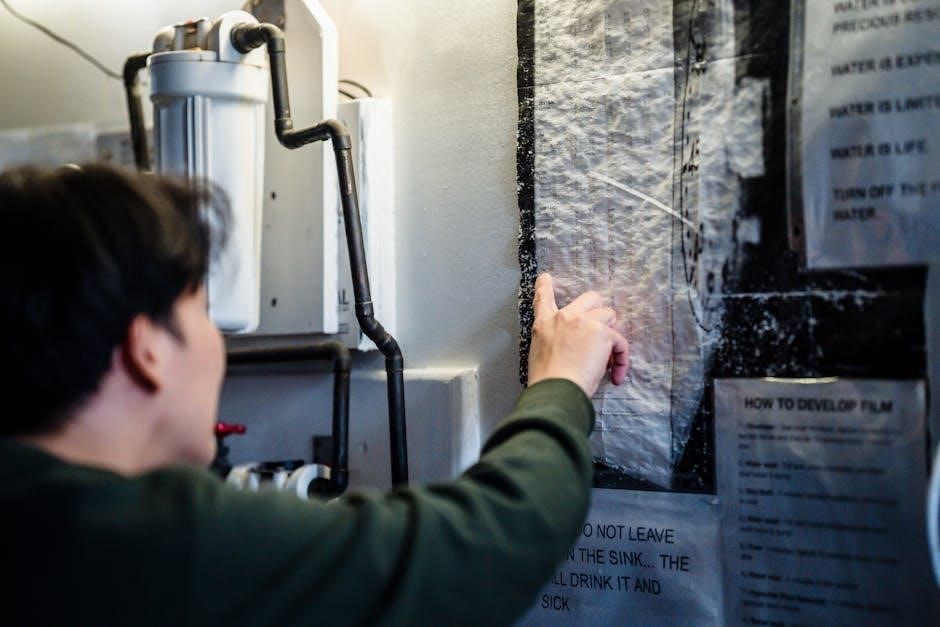Mastering Spanish opens doors to rich cultural connections and global communication. This guide provides essential tools, from vocabulary to grammar, helping learners confidently navigate the Spanish language with ease and clarity.
1.1. Overview of Spanish Language Basics
Mastering the basics of Spanish is the foundation for effective communication. Essential phrases and greetings like “Hola, ¿cómo estás?” (Hello, how are you?) and “Me llamo” (My name is) are crucial for everyday interactions. Vocabulary building includes numbers, days, and time-related terms, which are vital for navigation and scheduling. Understanding grammar fundamentals, such as verb conjugations and noun gender rules, is also key. For instance, verbs like ser (to be) and estar (to be) are essential for describing oneself and surroundings. Pronunciation tips and common expressions help learners sound natural. Starting with these basics ensures a strong grasp of the language, making further learning easier and more enjoyable. Consistent practice and immersion are recommended to reinforce these foundational elements and build confidence in speaking Spanish.

1.2. Importance of Spanish in Global Communication
Spanish is the second most widely spoken native language globally, with over 460 million native speakers and an additional 90 million bilingual speakers. It is an official language in 20 countries and widely used in international organizations. Knowing Spanish enhances career opportunities in fields like business, tourism, and diplomacy, particularly in Latin America and Spain. It also fosters cultural understanding and bridges gaps between diverse communities. In the U.S., Spanish is the second most spoken language, making it invaluable for domestic communication. Additionally, Spanish is a key language in global media, literature, and entertainment. Mastery of Spanish not only expands personal and professional horizons but also enriches one’s ability to connect with a vast and vibrant cultural network worldwide. As globalization increases, Spanish remains a critical tool for effective communication in an interconnected world.

Vocabulary Building
Building a strong vocabulary is foundational for effective Spanish communication. Start with essential phrases, greetings, and time-related terms. Use interactive tools like flashcards to memorize and practice consistently for confidence.

2.1. Essential Phrases and Greetings
Mastering essential phrases and greetings is the first step in learning Spanish. Common greetings like Hola (Hello), Buenos días (Good morning), and Buenas noches (Good evening) are fundamental. Phrases such as ¿Cómo estás? (How are you?) and Me llamo (My name is) help establish basic interactions. Understanding formal and informal language is key to using these greetings appropriately. For instance, tú and usted differentiate between casual and respectful interactions. These phrases are vital for building rapport and initiating conversations. Consistent practice with tools like flashcards or language apps can reinforce memory and improve fluency. Start with simple expressions to create a solid foundation for more complex communication.

2.2. Numbers, Days, and Time-Related Vocabulary
Mastery of numbers, days, and time-related vocabulary is crucial for effective communication in Spanish. Numbers like uno (one), dos (two), and diez (ten) are essential for counting and quantifying. Days of the week, such as lunes (Monday) and domingo (Sunday), help in scheduling and planning. Time expressions like la hora (the hour) and las horas (the hours) are vital for discussing schedules and appointments. Phrases like ¿Qué hora es? (What time is it?) and hoy (today) are commonly used in daily interactions. These vocabulary items are foundational for tasks like telling time, counting money, and understanding calendars. Practice with flashcards or language apps can enhance memorization. Consistent use of these terms in sentences will improve fluency and accuracy in real-life conversations.

Grammar Fundamentals
Understanding Spanish grammar fundamentals is key to effective communication. Mastering verb conjugations, sentence structure, and gender rules provides a solid foundation for fluency and accurate expression in Spanish.
3.1. Present Tense Verb Conjugation
Mastering present tense verb conjugation is fundamental in Spanish. Regular verbs follow predictable patterns based on their endings (-ar, -er, -ir), with specific pronouns like yo, tú, and él/ella/usted. For example, “hablar” becomes “hablo, hablas, habla,” while “comer” changes to “como, comes, come.” Irregular verbs like “ser” (to be) and “tener” (to have) don’t follow these rules, requiring memorization. Understanding these conjugations is essential for constructing basic sentences and communicating effectively. Practice with flashcards or online tools can help reinforce these patterns, ensuring accuracy and fluency in everyday conversations.
3.2. Common Irregular Verbs in Spanish
Irregular verbs in Spanish are a key challenge for learners, as they don’t follow standard conjugation patterns. Verbs like “ser” (to be), “tener” (to have), and “venir” (to come) are essential but irregular. For example, “ser” has forms like “soy, eres, es” in the present tense, while “tener” becomes “tengo, tienes, tiene.” Other common irregular verbs include “decir” (to say), “hacer” (to do), and “estar” (to be). Mastering these verbs requires memorization and practice, as they appear frequently in daily conversations. Flashcards, interactive tools, and consistent practice with exercises can help build fluency. Understanding these irregularities is crucial for effective communication in Spanish, as they often carry vital meanings in sentences. Regular review and immersion through real-life examples will aid in conquering these challenging but essential verbs.
3.3. Nouns and Gender Rules
In Spanish, nouns are categorized by gender, either masculine or feminine, which affects their associated articles, adjectives, and pronouns. Most masculine nouns end in “-o” (e.g., “libro”) or a consonant (e.g., “niño”), while feminine nouns often end in “-a” (e.g., “casa”) or certain vowels. Exceptions exist, such as “la mano” (feminine) and “el día” (masculine). Understanding gender is crucial for correct sentence structure. Pluralization typically involves adding “-s” or “-es,” with gender remaining consistent (e.g., “libros” and “casas”). Mastery of noun gender requires memorization and practice, as there’s no universal rule. Flashcards, interactive tools, and real-life immersion can aid learning. Regular review and application in sentences will help solidify this fundamental concept of Spanish grammar, ensuring clearer and more accurate communication.

Conversation Skills
Mastering conversation skills in Spanish involves forming questions, expressing opinions, and engaging in discussions confidently. Regular practice with tools like flashcards or conversational AI enhances fluency and real-life interactions effectively.
4.1. Forming Basic Questions and Answers
Forming basic questions and answers in Spanish is foundational for effective communication. Start with question words like dónde (where), quién (who), and por qué (why). For example, ¿Dónde está la biblioteca? (Where is the library?).
Use phrases like ¿Cómo te llamas? (What’s your name?) and Me llamo… (My name is…). Practice numbers and time-related questions, such as ¿Cuántos días tiene este mes? (How many days are in this month?).
Master common expressions: ¿Habla inglés? (Do you speak English?) or Entiendo (I understand). Pair questions with responses like Si, voy todos los días (Yes, I go every day). Regular practice with tools like flashcards or conversational AI enhances fluency and real-life interactions effectively. This section provides essential vocabulary and structures to confidently express your thoughts and inquire about others’ perspectives in Spanish.

4.2. Asking for and Giving Opinions
Asking for and giving opinions in Spanish is crucial for meaningful conversations. Use phrases like ¿Qué te parece…? (What do you think of…?) or ¿Tú crees que…? (Do you think…?) to inquire about others’ views. For example, ¿Qué opinas sobre esta película? (What do you think about this movie?).
To express your own opinions, use structures like Creo que… (I think…) or Me parece que… (It seems to me…). For instance, Creo que es una buena idea (I think it’s a good idea).
Agreeing or disagreeing is also important. Say Estoy de acuerdo (I agree) or No estoy de acuerdo (I disagree). Practice with exercises like discussing topics or responding to statements to build confidence in sharing your thoughts in Spanish.

Cultural Context
Understanding Hispanic holidays, traditions, and common expressions enriches your Spanish learning experience, helping you connect with the culture and communicate authentically in everyday interactions and meaningful conversations.
5.1. Understanding Hispanic Holidays and Traditions
Hispanic culture is rich in vibrant holidays and traditions, offering insights into the community’s history and values. Celebrations like Día de los Muertos, Navidad, and Semana Santa highlight the importance of family, spirituality, and heritage. These events often feature unique customs, such as parades, traditional foods, and music, which are essential to understanding the cultural fabric. Learning about these festivities helps Spanish learners connect with native speakers on a deeper level, fostering mutual respect and appreciation. By engaging with these traditions, you can enhance your language skills while gaining a richer understanding of Hispanic identity and practices.
5.2. Common Expressions and Cultural References
Mastering common expressions and cultural references is crucial for fluent communication in Spanish. Phrases like “¿Dónde está la biblioteca?” (Where is the library?) or “Me gusta el helado” (I like ice cream) are everyday expressions that simplify interactions. Cultural references, such as “¡Hasta luego!” (See you later!) or “¡Buen provecho!” (Enjoy your meal!), add authenticity to conversations. Understanding idiomatic phrases like “Tomar el pelo” (to tease someone) or “Estoy entre las mismas” (I’m in the same situation) helps learners grasp nuances. These expressions often vary by region, reflecting diverse Hispanic cultures. Familiarizing yourself with them enhances your ability to connect with native speakers and navigate real-life scenarios effectively. By incorporating these phrases, you’ll sound more natural and engage more deeply in cultural exchanges.

Practice and Resources
Engage with interactive tools like Quizlet for flashcards and apps like SpanishPod101 for real conversations. Immerse yourself by watching Spanish media, listening to podcasts, and speaking with native speakers regularly.
6.1. Interactive Language Learning Tools
Interactive tools like Quizlet and SpanishPod101 offer dynamic ways to learn Spanish. Quizlet provides flashcards for vocabulary, while SpanishPod101 features audio and video lessons. Apps like Duolingo and Babbel engage users with gamified exercises, making learning fun and accessible. Additionally, platforms such as Cursa.app and VHL Central allow users to earn certificates and access hundreds of free courses and exercises. These tools cater to different learning styles, ensuring that learners can practice at their own pace, whether through reading, listening, or speaking exercises. They also incorporate real-life scenarios, helping learners apply their knowledge practically. By utilizing these resources, students can enhance their language skills effectively and stay motivated throughout their learning journey.
6.2. Techniques for Real-Life Immersion
Real-life immersion is a powerful way to accelerate Spanish learning. Engage in conversations with native speakers through language exchange programs or apps like Tandem. Watch Spanish movies, listen to music, and follow Spanish media to absorb the language naturally. Practice speaking regularly, even if it’s just a few minutes a day. Use tools like ChatGPT to simulate real conversations, helping you build fluency. Immerse yourself by changing your device’s language settings to Spanish and labeling household items with their Spanish names. Join local Spanish-speaking groups or attend cultural events to practice in authentic settings. Consistent immersion, even in small doses, helps you connect with the language and culture on a deeper level, boosting confidence and fluency over time.
Mastering Spanish is a rewarding journey that enhances communication, cultural understanding, and personal growth. This guide has provided a comprehensive roadmap, covering essential vocabulary, grammar, conversation skills, and cultural insights. Consistent practice, paired with real-life immersion, is key to fluency. By leveraging interactive tools, engaging in meaningful conversations, and embracing Hispanic traditions, learners can deepen their connection to the language. Remember, language learning is a lifelong process, and every effort brings you closer to confidently expressing yourself in Spanish. Keep exploring, practicing, and immersing yourself in the rich world of Spanish culture and communication.
